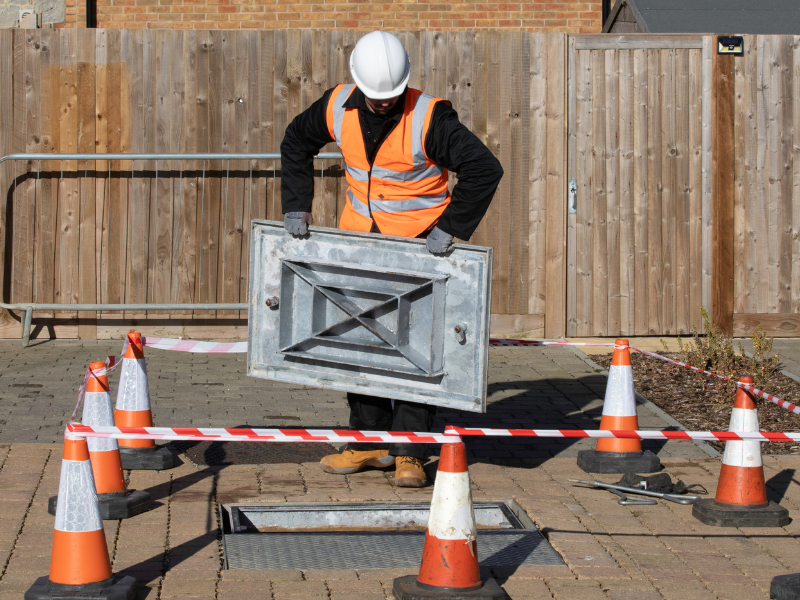Your Guide to Drainage Systems, Petrol Interceptors and Grease Traps
July 24, 2025
Protect Your Business with Smarter Wastewater Solutions — From Kitchen Fats to Fuel Runoff, We've Got You Covered
As experts in water and wastewater management, Willow Pumps is here to help you understand the essential systems that protect your site, prevent costly damage, and support regulatory compliance. Whether you manage a commercial kitchen, industrial site or fuel forecourt, maintaining effective drainage systems, petrol interceptors, and grease traps is critical.
 How Drainage Systems Work
How Drainage Systems Work
A well-designed drainage system is essential for managing the flow of surface water and groundwater, directing it safely away from buildings, roads and landscaped areas. This prevents flooding, erosion and water damage.
Drainage systems typically follow four key stages:
- Collection: Surface water is captured by grates, gutters, and ditches. Subsurface systems collect water that has soaked into the ground using underground pipes.
- Conveyance: Water is moved from collection points to discharge areas via gravity or pumps. In flat areas or those below sewer level, pumps are essential to move water uphill.
- Filtration and Treatment (Optional): In modern stormwater management, filters and green infrastructure (e.g., rain gardens or permeable paving) help remove debris and pollutants.
- Discharge: Treated or redirected water is safely discharged into sewers, natural watercourses, or dedicated retention basins.
Drainage System Maintenance Requirements
- Routine cleaning of gullies, gutters, pipes and drains using jet vacuum or combination units.
- Annual CCTV surveys to identify blockages, damage or root ingress.
- Monitoring surrounding vegetation that may enter channels or cause disruption.
Benefits of a Well-Maintained Drainage System
- Reduces flood risk and waterlogging
- Protects buildings and infrastructure
- Improves site safety and public health
- Supports sustainable urban development
- Helps protect the environment from runoff-related damage
What Are Petrol Interceptors and How Do They Work?
Petrol interceptors, also known as oil separators, are key to managing surface water runoff in areas where there’s a risk of fuel or oil contamination. Commonly used in fuel forecourts, car parks and industrial sites, they ensure that hydrocarbons don’t enter the watercourse.
How Petrol Interceptors Work
- Entry: Contaminated water enters the interceptor where flow is slowed to allow separation.
- Separation: Oils and fuels float to the surface, while heavier materials settle. Internal baffles guide water through the system while containing contaminants.
- Discharge: Clean water is released into the drainage system, while oils remain contained.
- Collection: Oils and sediments accumulate and are removed during scheduled maintenance using a tanker.
Types of Petrol Interceptors
- Full Retention Interceptors: Treat all water, ideal for high-risk areas like petrol stations.
- Bypass Interceptors: Used in lower-risk sites; excess rainwater bypasses treatment during heavy flow.
- Forecourt Interceptors: Specially designed for concentrated spills on fuel station forecourts.
Petrol Interceptor Maintenance Requirements
- Six-monthly cleans to remove accumulated oils and sediments
- Routine servicing to ensure optimal performance and environmental compliance
Benefits of Petrol Interceptors
- Prevents oils and fuels from entering watercourses
- Ensures compliance with environmental regulations
- Reduces environmental risk from surface water runoff
What Are Grease Traps and Why Are They Important?
Grease traps, also known as grease interceptors or recovery units, are essential in commercial kitchens and food establishments. They prevent fats, oils and grease (FOG) from entering the public sewer system, reducing the risk of blockages and sewer overflows.
How Grease Traps Work
- Entry: Wastewater from sinks or dishwashers enters the grease trap, where a flow restrictor reduces velocity for effective separation.
- Separation: FOG rises to the top while solids sink. Baffles help slow the water and separate the FOG.
- Discharge: Cleaner water exits to the sewer, while the FOG remains trapped inside.
- Collection: Accumulated grease and solids are removed during scheduled maintenance visits, typically every quarter.
Types of Grease Traps
- Passive Grease Traps: Compact units ideal for low-flow applications, often fitted under sinks.
- Grease Recovery Units (GRUs): Continuously separate and store grease for easy disposal.
- Hydromechanical Grease Interceptors: Use flow controls and air entrainment to enhance separation. These units are compact and efficient for small to medium establishments.
- Gravity Grease Interceptors: Larger tanks often installed underground, these are used to handle high volumes of wastewater.
Grease Trap Maintenance Requirements
- Quarterly empties and cleans using a vacuum tanker
- Quarterly servicing to inspect for blockages and ensure efficient operation
Benefits of Grease Traps
- Prevents sewer blockages caused by FOG
- Protects kitchen operations and municipal infrastructure
- Ensures compliance with health and environmental standards
- Reduces foul odours and emergency callouts
Why Choose Willow Pumps?
At Willow Pumps, we bring over 30 years of expertise in pumping, drainage, and wastewater solutions. As part of Franchise Brands plc, we work closely with our sister companies Metro Rod—drainage expert—and Filta, experts in commercial kitchen grease management. Together, we deliver a fully integrated service for businesses across a wide range of sectors.
Our specialist teams offer:
- Drainage system installation and maintenance
- Expert servicing and cleaning of petrol interceptors
- Comprehensive grease management services, including grease trap installation, emptying, and compliance advice
Whether you're looking to upgrade your drainage system, service your grease trap, or ensure your petrol interceptor meets environmental standards, you can trust Willow Pumps to deliver professional, compliant, and cost-effective solutions.
 How Drainage Systems Work
How Drainage Systems Work